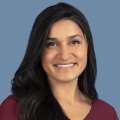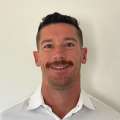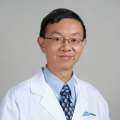The jugular vein collapsed on screen, opening and closing like a misshapen mouth, as a crowd of high school students looked on.
“I did not expect to be doing an ultrasound today,” said Mason Christian, a 17-year-old junior at El Segundo High School, who wielded the ultrasound probe that captured the vascular activity in his classmate’s neck.
Guided by a team of UCLA Health anesthesiologists, about 40 El Segundo High School students got a hands-on experience with ultrasound technology recently as part of , a biomedical science curriculum aimed at inspiring high school students to pursue medical careers.
In collaboration with the California Society for Anesthesiologists, UCLA Health’s has pioneered Project Lead the Way’s efforts in California since 2017. A national nonprofit, Project Lead the Way trains teachers to offer a biomedical curriculum, while physicians and other professionals volunteer to provide mentorship and hands-on trainings for students.
UCLA Health conducts the program at three Los Angeles-area high schools — El Segundo, Venice and Girls Academic Leadership Academy — and serves as a model for similar programs in Northern California led by Stanford and UC Davis.
For , who directs UCLA Health’s partnership with Project Lead the Way, the program speaks to her passions: community involvement, mentorship and “inspiring students from all backgrounds to pursue advanced education and careers in biomedical fields.”
“One of the things I love most about engaging with the students is getting to witness their ‘a-ha' moments, where the biomedical topics that they've learned in the classroom come to life as we discuss real-world clinical scenarios and immerse them in hands-on simulations,” Dr. Poorsattar said. “The reception has been overwhelming, with the impact felt well beyond the classroom.”
For the students, connecting with UCLA Health physicians and getting an up-close look at advanced medical practices are the highlight of the program.
“These visits are incredible,” said 16-year-old Carter Hajt, who volunteered his neck for the jugular-vein ultrasound scan. “I’ve absolutely loved them.”
Biomedical education in high school
The biomedical sciences curriculum for high school students spans all four years, introducing students to forensics, human body systems, medical interventions and biomedical innovations.
“It offers students more hands-on opportunities than any high-school level science course and sometimes more than even some early medical undergraduate courses,” said El Segundo High School teacher Tiffany Maisonet, a Project Lead the Way instructor and mentor.
“I always tell my students that I never got to do the things they are doing until I was in grad school!” she said. “This pathway puts students in the driver’s seat by allowing them to design experiments, develop medical and forensic analysis, ask the questions they want to and, most importantly, feel like they are already members of the health care community.”
Carter said the things he’s learned in his Project Lead the Way classes have already come in handy in his everyday life.
“I use it daily, honestly,” he said. “Last summer, one of my friends got hit by a firework, which was crazy, and I had to help him using these biomedical terms.”
Mason, who performed the ultrasound exam, has long loved science, which is what drew him to Project Lead the Way classes. And while he initially imagined becoming a neurosurgeon, his experiences with the biomedical curriculum have helped him refine his aspirations.
“I feel like I’m a lot more interested in research than being in a clinic,” Mason said of his plans to pursue a PhD. “So I’m going to do biomed or biology in undergrad and then hopefully do research when I graduate.”
Six doctors on campus
During the visit at El Segundo High School, six UCLA Health anesthesiologists fielded student questions — “What made you want to be a doctor?” “How long are your shifts?” “What do medical schools look for?” — before demonstrating ultrasound technology with small transducers and iPads.

Students rotated between three stations: checking out veins and arteries in the neck and wrist; exploring vertebral anatomy to understand nerve blocks and epidurals; and watching a volunteer doctor’s beating heart on the iPad screen.
Junior Ashlyn Sze took a turn applying the ultrasound transducer to the chest of anesthesiologist to look at his heart. She and her classmates identified its chambers and valves, asking questions as they went.
“I was astounded how (placing the probe) different places gives you different images,” said Ashlyn, 16.
Ashlyn signed up for the Project Lead the Way curriculum because she wants to be a pediatrician.
“This pathway has really opened me up to so many different professions that are beyond just being a doctor that you usually typically see,” she said, adding that she hopes to attend UCLA. “There’s so much more.”
For UCLA Health anesthesiology resident Maryte Gylys, MD, volunteering with the students was invigorating and inspiring.
“It reminds me why I went into this field in the first place,” said Dr. Gylys, who said that she, like many of the El Segundo students, knew in high school that she wanted to pursue a career in medicine.
Still, the students wowed her with their sophistication and knowledge.
“I was honestly very impressed by a lot of the questions that the kids were asking,” she said. “I felt that they showed a lot of interest and a higher level of thinking. I’m not sure I would have been able to ask those questions when I was in high school.”






